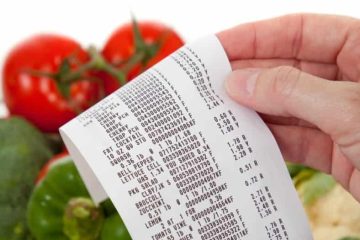Table of Contents
- Understanding the Cost of Living: A Comprehensive Overview of Food Prices in Canada
- Essential Strategies for Creating a Monthly Food Budget That Works for You
- Shopping Smart: Tips for Navigating Grocery Stores and Finding the Best Deals
- Meal Planning for Success: How to Save Time and Money in Your Weekly Food Prep
- Exploring Affordable Alternatives: Budget-Friendly Brands and Recipes to Try in Canada
- Q&A
- To Wrap It Up


Understanding the Cost of Living: A Comprehensive Overview of Food Prices in Canada
The cost of food in Canada can vary significantly based on a multitude of factors, including geographic location, seasonality, and market demand. Urban centers like Toronto and Vancouver often experience higher food prices compared to more rural areas due to increased transportation costs and a higher cost of living. Additionally, specialty items or organic products tend to command premium prices. Understanding these nuances is vital for creating a realistic food budget. Here are some factors to consider:
- Location: Cities generally have higher prices than small towns.
- Seasonality: Fresh produce prices can fluctuate significantly based on the time of year.
- Supply Chain: Disruptions can lead to price hikes on certain products.
The composition of a typical Canadian grocery bill reflects a mix of essential and non-essential items. Staples such as milk, bread, and eggs form the foundation of many households’ food budgets. However, the rising costs of these essentials can strain finances, forcing families to make difficult choices. The following table illustrates average prices for some common grocery items across major Canadian cities:
| Item | Toronto ($) | Vancouver ($) | Calgary ($) |
|---|---|---|---|
| Milk (1L) | 1.50 | 1.80 | 1.60 |
| Bread (500g) | 2.70 | 3.00 | 2.80 |
| Eggs (dozen) | 3.25 | 3.50 | 3.00 |
With fluctuating food prices, meal planning has emerged as an essential strategy for many Canadians looking to maximize their food budget. By prioritizing seasonal produce, buying in bulk, and cooking at home, individuals can not only save money but also promote healthier eating habits. Here are some practical tips to manage your food expenses effectively:
- Plan meals: Create a weekly menu to reduce impulse purchases.
- Use coupons: Take advantage of grocery store promotions and online discounts.
- Buy local: Supporting local farmers can often lead to better prices and fresher produce.


Essential Strategies for Creating a Monthly Food Budget That Works for You
Creating a food budget that suits your lifestyle in Canada requires understanding your spending habits and prioritizing your needs. Start by tracking your current food expenses for a month. This includes groceries, dining out, and any snacks or meal deliveries. Utilize budgeting apps or a simple spreadsheet to categorize your spending. By analyzing this data, you can identify areas where you may be overspending and set realistic limits for each category moving forward.
When establishing your budget, consider implementing some cost-effective strategies to stretch your dollar. One of the most effective ways is to plan your meals weekly. By choosing recipes based on what you already have at home and seasonal produce, you can keep costs down. Additionally, purchasing in bulk for items you use often can reduce expenses. Don’t forget about local markets and community-supported agriculture (CSA) programs, which often provide fresh produce at a lower price than traditional grocery stores. A diversified shopping list is key:
- Seasonal fruits and vegetables
- Canned goods and pantry staples
- Meats and proteins from bulk sources
- Whole grains and bulk grains
- Dairy alternatives or local dairy
it’s essential to review and adjust your budget regularly. Life changes and unexpected expenses can impact your initial budget. Set aside some time at the end of each month to reflect on your spending and see if your budget needs tweaking. Engaging in meal prep for the upcoming weeks can also help prevent impulse buys and reduce food waste, leading to greater savings.
| Category | Monthly Budget | Actual Spending |
|---|---|---|
| Groceries | $200 | $220 |
| Dining Out | $100 | $80 |
| Snacks/Extras | $50 | $60 |
| Total | $350 | $360 |


Shopping Smart: Tips for Navigating Grocery Stores and Finding the Best Deals
Shopping for groceries can be overwhelming, especially when trying to stick to a budget. One effective strategy is to plan your meals around what’s on sale. Start by checking weekly flyers or store apps for promotions. This ensures you can make a shopping list that prioritizes discounted items, ultimately saving you money. Here are some additional tips:
- Buy seasonal produce: Fruits and vegetables that are in-season often cost less and taste better.
- Consider store brands: Many grocery stores offer their own brands at a fraction of the price with comparable quality.
- Utilize coupons: Scan coupons from flyers, apps, or websites for potential additional discounts.
Another smart strategy at the grocery store is to navigate the aisles efficiently. Stick to the outer aisles where fresh foods are typically located, as they are healthier and usually priced better. Avoid the temptation of processed foods found in the middle aisles, they can wreak havoc on both your health and your wallet. You can also use packaging labels to your advantage:
- Assess unit prices: Pay attention to unit prices to find the best deals.
- Check expiration dates: Ensure you purchase items that will last until you intend to use them.
- Look for bulk options: Buying in bulk can provide significant savings on non-perishable items.
Lastly, build a relationship with your local grocery store staff. Familiarize yourself with the employees and ask about upcoming sales or discounts. Some stores may have loyalty programs that provide additional perks. Consider the following table that highlights typical store savings strategies:
| Strategy | Potential Savings |
|---|---|
| Meal Planning | Up to 30% |
| Seasonal Shopping | 15-25% |
| Using Coupons | Varies |


Meal Planning for Success: How to Save Time and Money in Your Weekly Food Prep
Meal planning is an effective strategy to not only enhance your cooking skills but also keep your finances in check. By organizing your meals ahead of time, you gain the ability to purchase ingredients in bulk, which often leads to significant savings. Additionally, consider buying seasonal produce, as it’s typically less expensive and fresher. To craft a balanced meal plan, incorporate a mix of proteins, grains, and seasonal vegetables. This approach can help you eat healthier while staying within your budget.
Another key component of successful meal planning is to utilize versatile ingredients across multiple meals. For instance, you can roast a batch of chicken on Sunday and use it throughout the week in salads, wraps, or stir-fries. Not only does this method save time during your busy weekdays, but it also minimizes food waste. Here are some versatile staples to include in your grocery list:
- Quinoa or brown rice: great bases for salads and bowls.
- Beans or lentils: provide protein and fiber for various dishes.
- Seasonal vegetables: act as sides or main ingredients.
- Eggs: perfect for quick breakfasts or easy dinners.
Tracking your expenses throughout the meal planning process can also contribute to your financial success. Create a simple table to monitor your weekly spending, comparing the costs of ingredients versus your budget. This can help identify areas for savings or adjustments in your meal planning. Here’s a quick example of a tracking table:
| Item | Cost |
|---|---|
| Chicken Breast (1kg) | $10 |
| Brown Rice (1kg) | $3 |
| Seasonal Vegetables | $5 |
| Eggs (dozen) | $3 |


Exploring Affordable Alternatives: Budget-Friendly Brands and Recipes to Try in Canada
When trying to stretch your food budget in Canada, embracing budget-friendly brands is a savvy approach. Many local grocery stores now offer their own label products that provide good quality at a fraction of the cost of name brands. Look for products labeled as “store brand” or “private label;” they often include everything from staples like pasta and rice to snacks and canned goods. Not only can you save money, but you may also discover new favorites you never knew existed.
In addition to budget brands, exploring various recipes can significantly benefit your wallet. Simple ingredients can be combined creatively to yield delicious meals. Consider trying the following recipes that are both economical and flavorful:
- Vegetable Stir-Fry: Use seasonal veggies and toss them in a bit of soy sauce and garlic for a quick meal.
- Chickpea Curry: Combine canned chickpeas, tomatoes, and spices for a hearty dish that’s filling and nutritious.
- One-Pot Pasta: Mix pasta, broth, and your choice of mixed veggies in one pot for an easy, affordable dinner.
| Ingredient | Budget Brand Examples | Approx. Cost |
|---|---|---|
| Rice | Great Value, No Name | $1.50/kg |
| Canned Tomatoes | Western Family, Compliments | $0.99/can |
| Pasta | Barilla, President’s Choice | $1.20/500g |
Implementing these strategies not only helps you save but also encourages a culinary adventure. The creativity you bring to your cooking can transform budget meals into delightful dining experiences. Plus, involving family or friends in meal prep can turn it into a fun activity, proving that enjoying good food doesn’t have to break the bank.




0 Comments